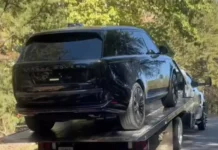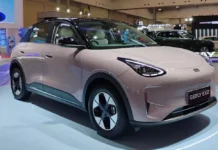Boxer engine, 4-wheel drive system, powerful racing cars… These are what make up Subaru’s brand in its nearly a century-long history of development.
>> Subaru Vietnam listens to customer opinions
>> New Subaru Forester to be launched in Vietnam
>> Subaru Tribeca Touring – Worth the price?
The Pleiades star
Subaru is a car manufacturer and brand name of Fuji Heavy Industries (FHI) of Japan.
The brand is known internationally for its use of boxer engines in most of its cars with engine capacity over 1500cc. Subaru’s all-wheel drive system, introduced in 1972, has become a standard feature for midsize and small cars at most international auto shows since 1996. They also sell many turbocharged versions of their compact cars, such as the Impreza WRX.
 Subaru is the Japanese name for the Pleiades star cluster
Subaru is the Japanese name for the Pleiades star cluster
Fuji Heavy Industries, Subaru’s parent company, currently has a partnership with Toyota Motor Corporation, which owns a 16.5% stake in FHI.
Subaru is the Japanese name for the Pleiades star cluster, which is depicted in the Subaru logo and symbolizes the 6 member companies of FHI.
The name Subaru
FHI started as The Aircraft Research Laboratory in 1917, headed by Chikuhei Nakajima. In 1932, the company was reorganized as Nakajima Aircraft Company, and soon became the main aircraft manufacturer for Japan during World War II.
After the war, Nakajima Aircraft was reorganized as Fuji Sangyo Co, Ltd. In 1946, the company produced the lightweight Fuji Rabbit motor scooter with aircraft parts from the war. In 1950, Fuji Sangyo was divided into 12 smaller companies under Japanese government legislation of 1950, which aimed at breaking up the zaibatsu.
Between the years 1953-1955, 4 of the above-mentioned companies, including the lightweight scooter manufacturer Fuji Jidosha, the truck body maker Utsunomiya Sharyo, the engine maker Omiya Fuji Kogyo, and the chassis maker Tokyo Fuji Dangyo, and a newly formed corporation Fuji Kogyo decided to merge together to form the famous heavy industrial conglomerate Fuji famous these days.
Kenji Kita, during his time as the CEO of Fuji Heavy Industries, desired the company to be involved in car manufacturing and soon began plans for building a car with the development code-name of P-1. Kita canvassed the company for suggestions about naming the P1, but none of the proposals were appealing enough.
Finally, he gave the car a Japanese name he had previously used as a pen name for his childhood writings: Subaru. The first Subaru was the Subaru 1500. Only 20 of these cars were manufactured. From 1954 to 2008, the company designed and manufactured numerous cars including the 1500 (1954), the 360 (1958) with its super-small air-cooled engine, the Sambar (1961), the 1000 (the car that featured the development code-name “Boxer” engine seen in 1965), the R-2 (1969), the Rex and Leone (1971), the BRAT (1978), the Alcyone (1985), the Legacy (1989), the Impreza (1993), the Forester (1997), the Tribeca (2005), and the Exiga (2008).
Racing cars
Subaru Rally Team Japan, headed by Noriyuki Koseki (the founder of Subaru Tecnica International STI), campaigned used Subaru Leone coupés, sedan DL, RX (SRX) and RX Turbo in the World Rally Championship from 1980 to 1989. Outstanding drivers included Ari Vatanen, Per Eklund, Shekhar Mehta, Mike Kirkland, Possum Bourne, and Harald Demut. Mike Kirkland completed all 6 rounds and won the A Group of the 1986 Safari Rally. That year, Subaru was one of the few manufacturers combining 4WD and turbo. Subaru switched racing to the Legacy RS in 1990-1992 and entered into the first season of the World Rally Championship with a similar model in 1993.
 Subaru has left a mark on the World Rally Championship
Subaru has left a mark on the World Rally Championship
The modified versions of the Impreza WRX and WRX STI have been quite successful in racing; exceptional drivers Colin McRae (1995), Richard Burns (2001), and Petter Solberg (2003) won the overall World Rally Championship title with the Subaru World Rally Team, and Subaru won the manufacturer’s title three consecutive years 1995-1997.
On December 16, 2008, Subaru announced that it would withdraw from the World Rally Championships due to issues with the ongoing global economic crisis, along with the potential for development of the 2009 season and rule changes for the 2010 season.
Beginning in 2006, Subaru of America (SOA), the official distributor of Subaru vehicles in the United States, engaged in the Subaru Road Racing Team (SRRT) with a Subaru Legacy 2.5 GT Spec-B in the Grand-Am Street Tuner class. In 2010, SRRT campaigns with a Subaru Impreza WRX STI in the Grand Sport class.
Diesel engines
At the 2007 International Motor Show in Frankfurt, Subaru introduced a horizontally-opposed, water-cooled, common-rail direct-injection turbodiesel engine with a variable geometry turbocharger called the Subaru EE engine, the first engine of this kind to be fitted to a passenger car.
In the 1950s, Volkswagen experimented with this type of idea, producing two diesel prototype boxer engines that air-cooled without turbocharging with one engine at Type 1, and another at Type 2.
The Subaru engine is rated at 110 kW and 350 Nm with a displacement of 2.0 liters. In March 2008, Subaru launched the Legacy sedan and wagon, Outback wagon with a 2.0-liter turbodiesel in the EU with a 5-speed manual transmission.
In September 2008, Subaru announced that the Forester diesel and Impreza diesel were introduced to the Paris Motor Show 2008, with Forester sales starting in October 2008 and Impreza diesel sales starting in January 2009. The Forester and Impreza have a 6-speed manual transmission, while the Legacy and Outback have a 5-speed manual transmission.
Thu Ha (TTTD)






































